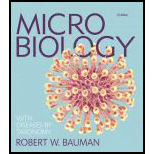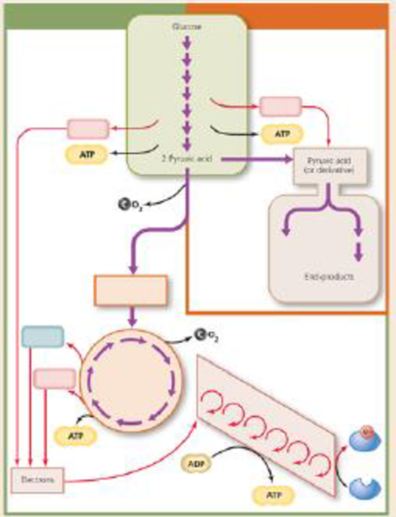
Microbiology with Diseases by Taxonomy (5th Edition)
5th Edition
ISBN: 9780134019192
Author: Robert W. Bauman Ph.D.
Publisher: PEARSON
expand_more
expand_more
format_list_bulleted
Concept explainers
Textbook Question
Chapter 5, Problem 2VI
Label the diagram below to indicate acetyl-CoA, electron transport chain, FADH2, fermentation, glycolysis, Krebs cycle, NADH, and respiration. Indicate the net number of molecules of ATP that could be synthesized at each stage during bacterial respiration of one molecule of glucose.

Expert Solution & Answer
Want to see the full answer?
Check out a sample textbook solution
Students have asked these similar questions
Complete the table ATP Yield from Anaerobic Respiration (for 1 Glucose Molecule)
b) Place a 'Yes' or a 'No' in the appropriate boxes that correspond to
each listed feature of cellular respiration. You may need to state
'Yes' or 'No' in more than one box in a particular row in some
cases.
Cellular
Respiration
Feature
Involved in
aerobic
respiration
Occurs in the
mitochondrial
matrix
Pyruvate
molecules are
produced
Acetyl COA
combines with a
4 carbon
molecule
Electrons are
passed between
protein carriers
ATP is produced
NAD+ gains
hydrogen
FADH₂ loses
hydrogen
Glycolysis
Yes / No
Krebs Cycle
Yes / No
Electron
Transport chain
Yes / No
For Krebs Cycle(Citric Acid Cycle) what are steps of cellular respiration for both aerobic (oxygen present) and anaerobic (without oxygen) respiration. what are the
Inputs and Outputs: Clearly indicate the key substrates, intermediates, and products at each stage.
Location: Show where this stage of cellular respiration occurs within the cell (e.g., cytoplasm, mitochondria).
Energy Production: Highlight the ATP and NADH production at this stage.
Oxygen: Show where oxygen is used in the process (e.g., ETC) and where carbon dioxide is produced.
Electron Carriers: Indicate the role of electron carriers such as NAD+ and FAD in transferring eleDiagrams: Use diagrams or icons to represent the structures and molecules involved, such as the mitochondria, glucose, ATP, and oxygen.
Key Information like important facts or formulas relevant to cellular respiration, like the chemical equations for each stage.
Chapter 5 Solutions
Microbiology with Diseases by Taxonomy (5th Edition)
Ch. 5 - Prob. 1MCCh. 5 - Prob. 2MCCh. 5 - Prob. 3MCCh. 5 - Prob. 4MCCh. 5 - Prob. 5MCCh. 5 - Prob. 6MCCh. 5 - Prob. 7MCCh. 5 - Prob. 8MCCh. 5 - Prob. 9MCCh. 5 - Prob. 10MC
Ch. 5 - Prob. 11MCCh. 5 - Prob. 12MCCh. 5 - Prob. 13MCCh. 5 - Prob. 14MCCh. 5 - Prob. 15MCCh. 5 - Prob. 16MCCh. 5 - Prob. 17MCCh. 5 - Prob. 18MCCh. 5 - Prob. 19MCCh. 5 - Prob. 20MCCh. 5 - Prob. 1MCh. 5 - Prob. 1FIBCh. 5 - Prob. 2FIBCh. 5 - Prob. 3FIBCh. 5 - Prob. 4FIBCh. 5 - Prob. 5FIBCh. 5 - Prob. 6FIBCh. 5 - Prob. 7FIBCh. 5 - Prob. 8FIBCh. 5 - Prob. 9FIBCh. 5 - Prob. 10FIBCh. 5 - Label the mitochondrion to indicate the location...Ch. 5 - Label the diagram below to indicate acetyl-CoA,...Ch. 5 - Examine the biosynthetic pathway for the...Ch. 5 - Prob. 1SACh. 5 - Prob. 2SACh. 5 - Prob. 3SACh. 5 - Prob. 4SACh. 5 - Prob. 5SACh. 5 - Prob. 6SACh. 5 - Prob. 7SACh. 5 - Prob. 8SACh. 5 - Prob. 9SACh. 5 - Prob. 10SACh. 5 - Prob. 11SACh. 5 - Prob. 12SACh. 5 - Prob. 13SACh. 5 - Prob. 14SACh. 5 - A laboratory scientist notices that a cer1ain...Ch. 5 - Arsenic is a poison that exists in two states in...Ch. 5 - Explain why an excess of all three of the amino...Ch. 5 - Prob. 3CTCh. 5 - Describe how bacterial fermentation causes milk to...Ch. 5 - Giardia intestinalis and Entamoeba histolytica are...Ch. 5 - Prob. 6CTCh. 5 - Prob. 7CTCh. 5 - Prob. 8CTCh. 5 - Cyanide is a potent poison because it irreversibly...Ch. 5 - How are photophosphorylation and oxidative...Ch. 5 - Prob. 11CTCh. 5 - Compare and contrast aerobic respiration,...Ch. 5 - Scientists estimate that up to one-third of Earths...Ch. 5 - Prob. 14CTCh. 5 - Prob. 15CTCh. 5 - Some desert rodents rarely have water to drink....Ch. 5 - Prob. 17CTCh. 5 - Prob. 18CTCh. 5 - Explain why hyperthermophiles do not cause disease...Ch. 5 - In addition to extremes in temperature and pH,...Ch. 5 - Prob. 21CTCh. 5 - Prob. 22CTCh. 5 - Prob. 23CTCh. 5 - Prob. 24CTCh. 5 - Prob. 25CTCh. 5 - A scientist moves a green plant grown in sunlight...Ch. 5 - What class of enzyme is involved in amination...Ch. 5 - Prob. 1CMCh. 5 - How can oxidation take place in an anaerobic...Ch. 5 - Prob. 2TMWCh. 5 - Prob. 3TMWCh. 5 - Prob. 4TMWCh. 5 - Prob. 5TMWCh. 5 - Prob. 6TMW
Knowledge Booster
Learn more about
Need a deep-dive on the concept behind this application? Look no further. Learn more about this topic, biology and related others by exploring similar questions and additional content below.Similar questions
- Please help fill out the tablearrow_forwardTable 8: ATP Yield from Anaerobic Respiration (for 1 Glucose Molecule) # of ATPS Generated through Substrate-Level Phosphorylation # of ATPS Generated from NADH and FADH, through Oxidative # of NADH and FADH, Produced Gross Subtotal of ATPS Produced Process Phosphorylation NADH: FADH2: Glycolysis NADH: FADH2: GROSS TOTAL of ATPS Produced # of ATPS Spent NETTOTAL of ATPS Produced Fermentationarrow_forwardConsider the steps of the krebs cycle and electron carrier chain and answer: a) How many ATPs are produced from 10 Pyruvato molecules? b) How many ATPs are produced from 12 Acetyl CoA molecules?arrow_forward
- Explain the following event in cellular respiration by accomplishing the table.arrow_forwardThe synthesis of acetyl-CoA from pyruvic acid serves as a bridge between which of the following pathways? glycolysis and the Krebs cycle the Entner-Douderoff pathway and the Krebs cycle CO glycolysis and fermentation glycolysis and the electron transport chain Krebs cycle and the electron transport chain uestion 21 the carbon dioxide produced during aerobic respiration is produced in the Krebs cyclearrow_forwardComplete the sentence describing the pentose phosphate pathway in cells that require much more ribose 5-phosphate than NADPH. These cells need ribose 5-phosphate but have relatively higher concentrations of NADPH and lower concentrations of NADP*. Choose from the listed words to fill in the blanks: xylulose 5-phosphate, fructose 6-phosphate, glucose 6-phosphate, five, two, three, glyceraldehyde 3- phosphate, erythrose 4-phosphate, sedoheptulose 7-phosphate. One molecule of and two molecules of are used to generate molecules of ribose 5-phosphate by the reverse reactions of the nonoxidative phase of the pentose phosphate pathway.arrow_forward
- Use drawings, flow charts, or a table to compare and contrast the energy inputs and outputs during each phase of aerobic respiration vs. fermentation. Be sure to directly discuss inputs and outputs of BOTH processes. Include all phosphorylated compounds and high-energy electron carriers, and briefly EXPLAIN HOW these are produced at each stage of respiration. WHERE does each stage happen? Explain HOW energy from high energy electron carriers is converted to ATP during respiration in mitochondria or aerobic bacteria.arrow_forwardDescribe redox reactions involved in the three steps of aerobic cellular respiration under the following topics: 1. Description of the two coenzymes NAD and FAD and link them to each enzyme in glycolysis; pyruvate oxidation and citric acid cycle using the backpack analogy that I described in class. (20%) 2. Describe energy harvesting of the electrons and hydrogens carried by the coenzymes in the electron transport chain and chemiosmosis using the battery analogy I described in class. (20%) 3. Describe the steps of DNA replication in bacteria as shown in our slides emphasizing the need for the Okazaki fragments (20%) 4. Describe RNA transcription emphasizing the two strands of DNA and the orientation of mRNA (20%) 5. Describe mRNA translation emphasizing the role of ribosomes and tRNA for two amino acids (20%)arrow_forwardSelect the correct statements about cellular respiration (select all that apply) 1) Chemical energy in glucose is transformed to the form of ATP 2)The over all equation for cellular respiration is C6H12O6 + 6O2 —> 6CO2 + 6H2O + 36ATP 3)Cellular respiration takes place in the ribosomes 4) The phases include glycolysis, the kraft cycle, and the electron transport 5) The overall equation for cellular respiration is glucose + oxygen —> carbon monoxide + water + ADP 6) The phases include glycolysis, the citric acid cycle, and the electron transport chain 7) The breakdown of ATP drives the synthesis of glucosearrow_forward
- Which of the following shows the correct order of reactions for aerobic respiration? Glycolysis → Pyruvate oxidation → Citric acid cycle → Chemiosmosis → Electron transport chain Glycolysis → Fermentation Glycolysis → Pyruvate oxidation → Citric acid cycle → Electron transport chain → Chemiosmosis Glycolysis → Fermentation → Pyruvate oxidation → Citric acid cycle → Electron transport chain → Chemiosmosis Pyruvate oxidation → Glycolysis → Citric acid cycle → Fermentationarrow_forwardFor Glycolysis what are steps of cellular respiration for both aerobic (oxygen present) and anaerobic (without oxygen) respiration. what are the Inputs and Outputs: Clearly indicate the key substrates, intermediates, and products at each stage. Location: Show where this stage of cellular respiration occurs within the cell (e.g., cytoplasm, mitochondria). Energy Production: Highlight the ATP and NADH production at this stage. Oxygen: Show where oxygen is used in the process (e.g., ETC) and where carbon dioxide is produced. Electron Carriers: Indicate the role of electron carriers such as NAD+ and FAD in transferring eleDiagrams: Use diagrams or icons to represent the structures and molecules involved, such as the mitochondria, glucose, ATP, and oxygen. Key Information like important facts or formulas relevant to cellular respiration, like the chemical equations for each stage.arrow_forwardlist three factor which influence enzymatic activity and list the four steps of cellular respiration and where they take place in the cell. Write the equation for cellular reespiration and photosynthesis indicate which reactant is oxdidized and which is reduced in both equationarrow_forward
arrow_back_ios
SEE MORE QUESTIONS
arrow_forward_ios
Recommended textbooks for you
 Human Physiology: From Cells to Systems (MindTap ...BiologyISBN:9781285866932Author:Lauralee SherwoodPublisher:Cengage Learning
Human Physiology: From Cells to Systems (MindTap ...BiologyISBN:9781285866932Author:Lauralee SherwoodPublisher:Cengage Learning

Human Physiology: From Cells to Systems (MindTap ...
Biology
ISBN:9781285866932
Author:Lauralee Sherwood
Publisher:Cengage Learning
Anaerobic Respiration; Author: Bozeman Science;https://www.youtube.com/watch?v=cDC29iBxb3w;License: Standard YouTube License, CC-BY